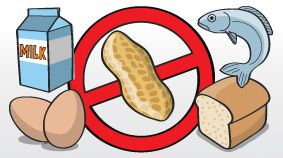

Clinic byte: Food Allergy Action Month
Source/Author: Marie Confident, RN, BSN
May 07, 2015
May is Food Allergy Action Month, and the week of May 10-16 is food allergy awareness week. Food allergies are on the rise, and it is estimated that one in 13 children under age 18 is affected. A food allergy is the immune system’s reaction to a food protein it mistakenly identifies as harmful. Initial exposure to the offending food creates a sensitization resulting in an immune response.
The following eight foods account for 90% of all food allergies:
1. Peanut
2. Tree nut
3. Milk
4. Egg
5. Wheat
6. Soy
7. Fish
8. Shellfish
Reactions may range from mild (rash, hives, itching) to anaphylaxis, a severe allergic reaction involving the entire body and is a medical emergency (swelling of throat, mouth, hoarseness, difficulty breathing, wheezing, loss of consciousness even death).
If a food allergy is suspected, the person is referred to an allergist who will determine the allergen through a comprehensive history and tests such as skin prick, blood, oral food challenge and trial elimination.
Strict avoidance of the food causing the allergy is the only way to prevent a potential anaphylactic reaction. It is very important to read ingredient labels all the time. While 80% of children eventually outgrow their allergy to cow’s milk, eggs and wheat by age 16, only 20% do for peanuts. Fish and shellfish allergies may develop at a later age and tend to be lifelong.
Mild reactions (itching and hives) are treated with over-the-counter antihistamine like Benadryl. Epinephrine or epipen is the drug of choice for anaphylactic reaction and requires a prescription.
Mild reactions (itching and hives) are treated with over-the-counter antihistamine like Benadryl. Epinephrine or epipen is the drug of choice for anaphylactic reaction and requires a prescription.
An anaphylactic reaction can happen any time and anywhere, so early recognition of symptoms and prompt administration of epipen will help save lives. People with history of anaphylaxis should carry their epipen with them at all times and wear emergency medical identification. Once an epipen is used, 911 should be called and the person needs to be transported by ambulance to an emergency room for further treatment and monitoring.
Parents: If your child has been prescribed an epipen for his/her allergy, I encourage you to bring it to the clinic by the first day of school. It needs to be in its original container with its attached label. An allergy action plan needs to be filled out and signed by parents.
At this time, there is no cure for food allergies, though clinical trials of promising new treatments (immunotherapy) are underway. Food Allergy Research and Education (FARE) is leading the way in raising public awareness, providing advocacy and education and advancing research to find a cure http://www.foodallergy.org/about.
Until next time, remain healthy and Happy Mother’s Day!
Marie Confident, RN, BSN
Shorecrest school nurse
























